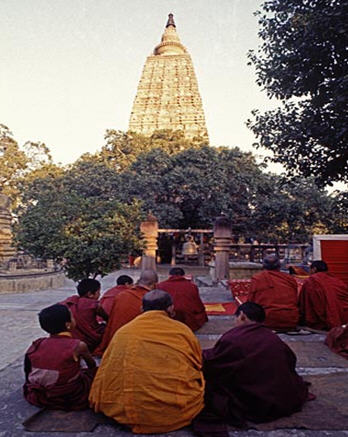Lumbini :
Lumbini is the birthplace of Lord Buddha, the apostle of peace, and nonviolence. It is situated 250 kilometers southwest of Kathmandu. The broken Ashokan pillar, remnants of an old monastery, images of Buddha’s mother Maya Devi, etc. are still preserved in Lumbini. It is accessible by air from Kathmandu to Bhairahawa. From Kathmandu it takes about eight hours by bus or car. From Bhairawa it is just 1 hour away.
Sometime during the sixth century BC, a solitary, wandering ascetic sat to meditate beneath a shady tree at Bodh Gaya, resolving not to rise until he had attained the ultimate knowledge of spiritual enlightenment. Thus began Buddhism, one of the world’s great religions and pilgrimage traditions.
Historians, religious scholars, and various Buddhist sects debate the actual year of the Buddha’s birth; it may have been as early as 644 BC or as late as 540 BC. It is, however, relatively certain that he was born as Prince Gautama Siddhartha, the son of Suddodhana, king of the Shakya tribe. His birthplace was the forest grove of Lumbini in the hilly regions of what is today northeastern India and Nepal. Miraculous events surrounded his birth. Sages prophesied that he would become either a powerful king or, renouncing his royal life, an enlightened being and religious leader. King Suddhodhana, wanting the former and fearing the later, sought to insulate his son from religious and philosophical concerns by surrounding him with a life of ease and plenty. Enclosed within palace walls, the prince grew to manhood and fatherhood never having seen old age, sickness, poverty or death.
Yet this blindness to the full range of human experience was not to last. One day the prince ventured beyond the castle walls and, witnessing the inevitable sufferings of human existence, recognized the shallowness of his pampered life. Metaphysical questions filled his mind and along with them the conviction that he must seek and know the great truth of life. Thus, at the age of twenty-nine, he let go the constraints of family and worldly responsibility to tread the path of self-discovery.
Following the ancient traditions of Hinduism, Siddhartha sought out spiritual teachers, or gurus. Inquiring of their knowledge, he diligently practiced various yogas and meditations. Seven years passed, the last three in extreme asceticism, yet still he had not achieved his goal of enlightenment. Finally recognizing that such practices had served him well but were no longer appropriate, Siddhartha journeyed toward the ancient sacred forests of Uruvela (modern Gaya in Bihar, in north India) with the intention of finally and completely realizing the infinite. Guided by visionary dreams and following in the footsteps of Krakucchanda, Kanakamuni, and Kasyapa, the Buddhas of three previous times, Siddhartha sat beneath the Bodhi Tree. Touching the earth, thereby calling it to witness the countless lifetimes of virtue that had led him to this place of enlightenment, he entered into a state of deep meditation. Three days and nights passed and his intention was realized. Siddhartha became the Buddha, meaning the ‘Enlightened One’.

Buddhist Monks at Bodhi Tree (The site of Buddha’s enlightenment)

Buddhist monks at Bodh Gaya.